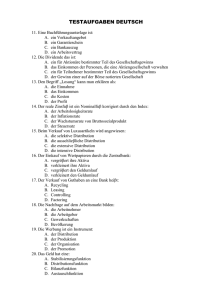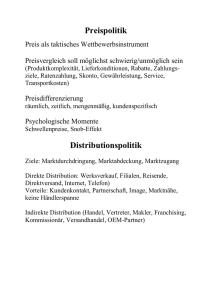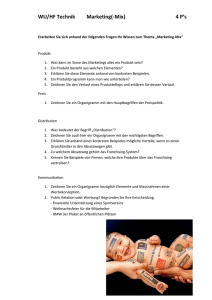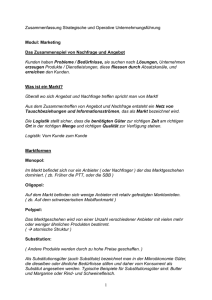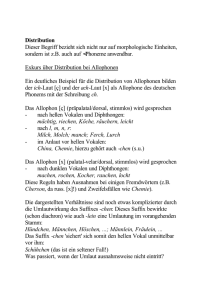¨Ubungen zu Integrierter Kurs II - Festkörper und Statistische Physik
Werbung
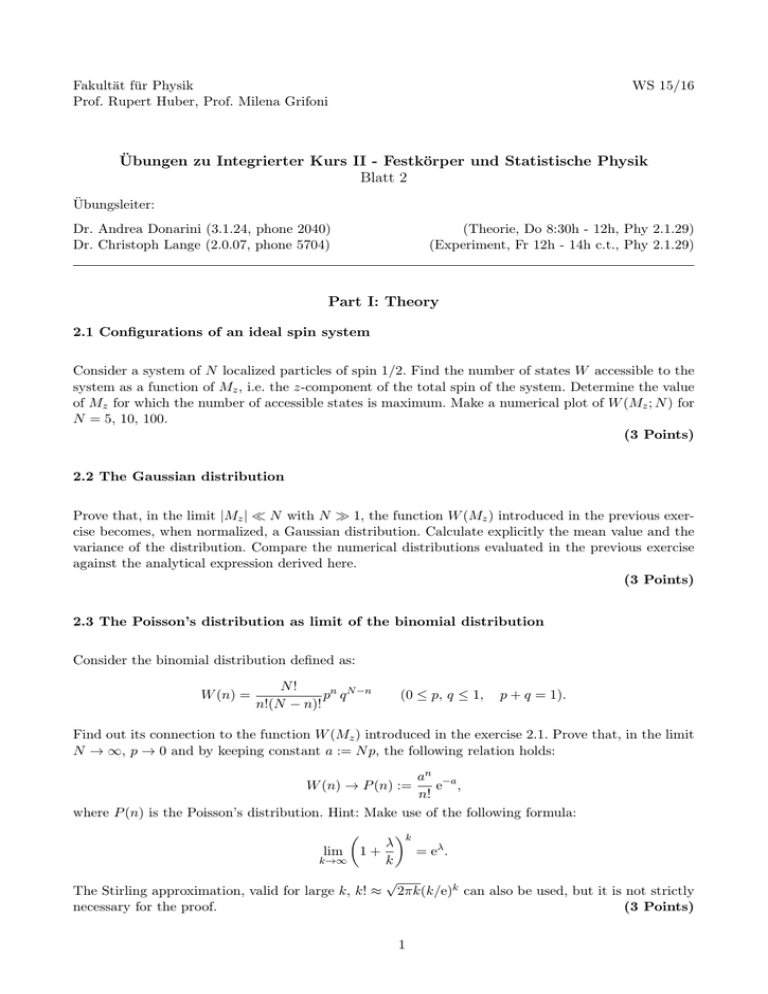
Fakultät für Physik Prof. Rupert Huber, Prof. Milena Grifoni WS 15/16 Übungen zu Integrierter Kurs II - Festkörper und Statistische Physik Blatt 2 Übungsleiter: Dr. Andrea Donarini (3.1.24, phone 2040) Dr. Christoph Lange (2.0.07, phone 5704) (Theorie, Do 8:30h - 12h, Phy 2.1.29) (Experiment, Fr 12h - 14h c.t., Phy 2.1.29) Part I: Theory 2.1 Configurations of an ideal spin system Consider a system of N localized particles of spin 1/2. Find the number of states W accessible to the system as a function of Mz , i.e. the z-component of the total spin of the system. Determine the value of Mz for which the number of accessible states is maximum. Make a numerical plot of W (Mz ; N ) for N = 5, 10, 100. (3 Points) 2.2 The Gaussian distribution Prove that, in the limit |Mz | N with N 1, the function W (Mz ) introduced in the previous exercise becomes, when normalized, a Gaussian distribution. Calculate explicitly the mean value and the variance of the distribution. Compare the numerical distributions evaluated in the previous exercise against the analytical expression derived here. (3 Points) 2.3 The Poisson’s distribution as limit of the binomial distribution Consider the binomial distribution defined as: W (n) = N! pn q N −n n!(N − n)! (0 ≤ p, q ≤ 1, p + q = 1). Find out its connection to the function W (Mz ) introduced in the exercise 2.1. Prove that, in the limit N → ∞, p → 0 and by keeping constant a := N p, the following relation holds: an −a e , n! where P (n) is the Poisson’s distribution. Hint: Make use of the following formula: W (n) → P (n) := lim k→∞ λ 1+ k The Stirling approximation, valid for large k, k! ≈ necessary for the proof. k √ = eλ . 2πk(k/e)k can also be used, but it is not strictly (3 Points) 1 2.4 Non cubic dices (Oral) Consider a set of M dices with K faces (who played role games at least once knows that there are at least dices with 4, 6, 10, 12 and 20 faces!). a) Which is the probability of rolling ni times the number i, with i = 1, . . . , K when rolling all the M dices? b) Write down the formal expression for the probability P (N ; M, K) of obtaining N by rolling the M dices with K faces and evaluate it numerically for different K and M . c) According to the central limit theorem prove that, in the limit of large M , the distribution evaluated in the previous point becomes: − 1 lim P (N ; M, K) = √ e M 1 2πσM,K (N −N̄M,K )2 2σ 2 M,K where , K +1 K2 − 1 2 and σM,K =M . 2 12 Compare the result with the numerical calculations. Hint: The following formula could be useful: N̄M,K = M K X i=1 i2 = K(K + 1)(2K + 1) 6 2 Part II: Experiment 2.5 Bindungstypen Obwohl wir zwischen verschiedenen Bindungstypen unterscheiden, treten diese in Festkörpern üblicherweise nicht in reiner Form auf. Diskutieren Sie, welche Bindungstypen in folgenden Festkörpern relevant sind und welcher Bindungstyp dominiert: Krypton, Kochsalz (NaCl), Natrium, Graphit, Diamant, Argon, GaAs, ZnO, Quarz, NH3 , CF4 , Polyethylen. (1 Punkt) 2.6 Modell des linearen Ionenkristalls a) Berechnen Sie die Madelungkonstante α einer linearen Ionenkette mit einfach negativ bzw. positiv geladenen Ionen, bezogen auf die Gitterkonstante a. Wie groß ist die Madelungkonstante, wenn sie auf den Abstand R nächster Nachbarn bezogen wird? (2 Punkte) b) Betrachten Sie eine Kette aus 2N Ionen mit den Ladungen ±e und dem abstoßenden Potential Ar−n zwischen nächsten Nachbarn. Zeigen Sie, dass für die innere Energie U im Gleichgewichtsabstand r = r0 gilt N e2 1 U (r0 ) = − 1− ln2. 2π0 r0 n Für welche n wäre der Kristall stabil? (1 Punkt) c) Welche Schwierigkeiten ergeben sich für die Berechnung der Madelung-Konstante im dreidimensionalen Kristall? 2.7 NaCl-Kristall NaCl kristallisiert in der kubisch-flächenzentrierten Geometrie (siehe Abb.) mit einer Gitterkonstanten von a = 5.44 Å. Neben der Coulombanziehung enthält das Gitterpotential einen abstoßenden Term ∝ b · r−β mit β = 8.9. Die Madelungkonstante des NaCl-Gitters ist α = 1.748. a a a Kubisch-flächenzentrierte Kristallstruktur a) Berücksichtigen Sie für die repulsive Wechselwirkung nur nächste Nachbarn und bestimmen Sie die Konstante b. (1 Punkt) b) Wie groß ist in diesem Fall die Bindungsenergie pro NaCl-Molekül? (1 Punkt) 2.8 Zweiatomige Moleküle Wir betrachten ein zweiatomiges Argon-Molekül. Die Bindungsenergie als Funktion des Abstands R der Atome ist gegeben durch σ 12 σ 6 U (R) = 4 − , R R wobei = 1.67×10−21 J und σ = 0.34 nm. Die Atommasse M von Ar beträgt 40 amu mit 1 amu=1.66× 10−27 kg. 3 a) Bestimmen Sie den Gleichgewichtsabstand R0 in Abhängigkeit von den Parametern σ und . (1 Punkt) b) Berechnen Sie die Frequenz der Schwingung des zweiatomigen Argon-Moleküls in harmonischer Näherung. (2 Punkte) c) Diskutieren Sie die Kraft F (R) = −dU/dR. In welchem Abstand R > R0 ist die Kraft maximal? (1 Punkt) 4
